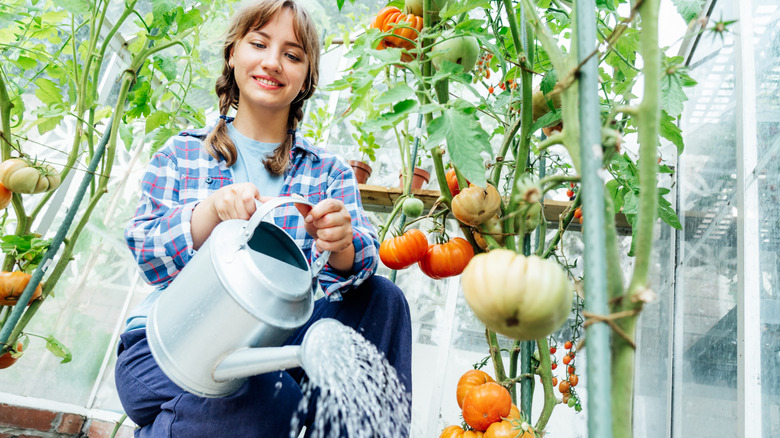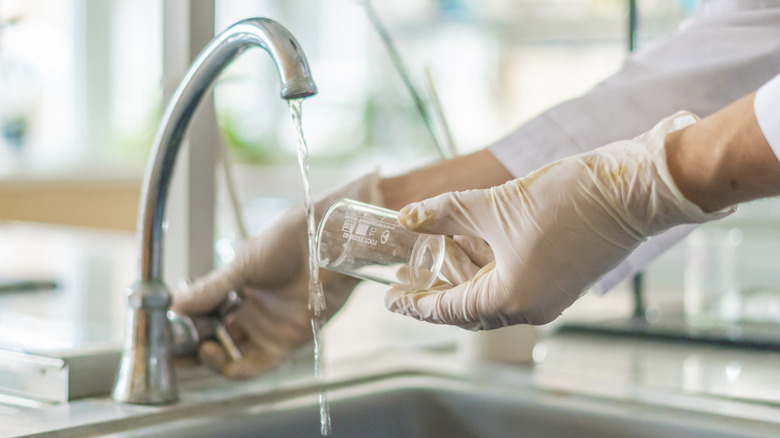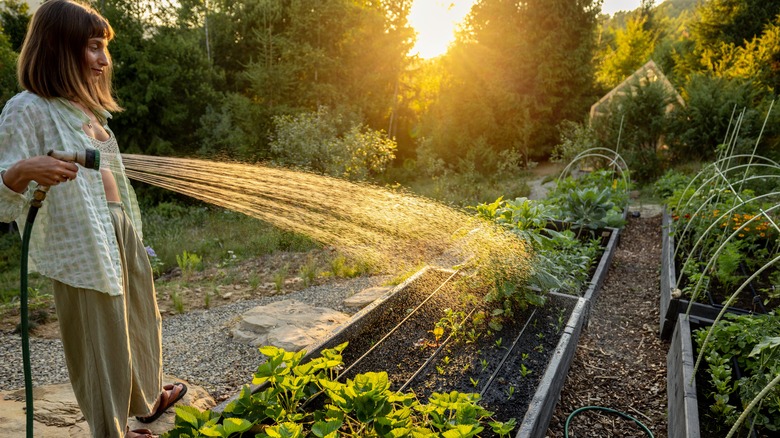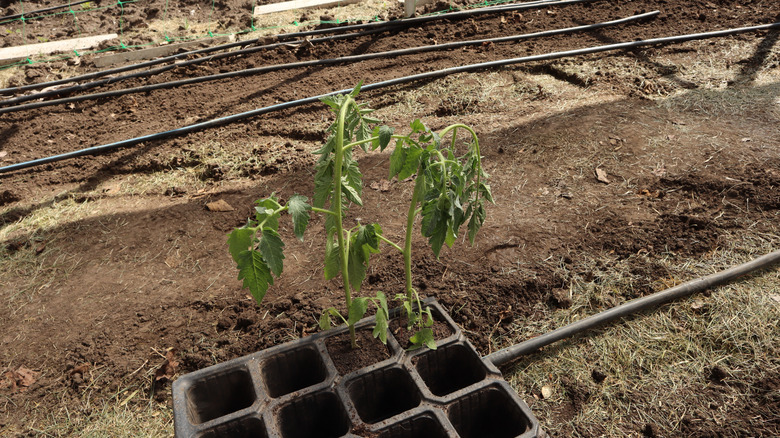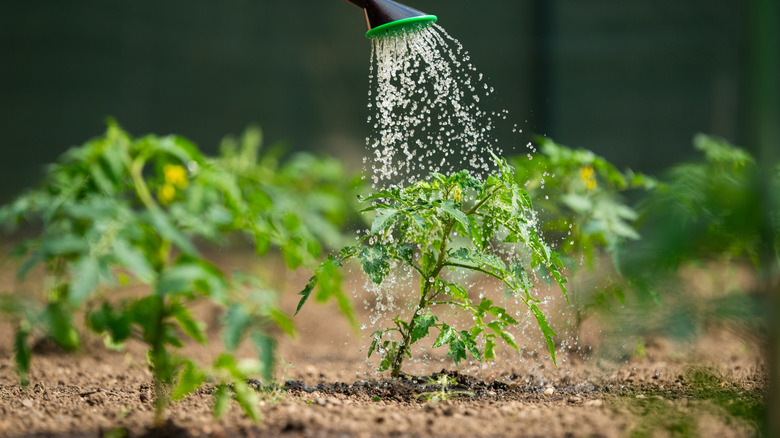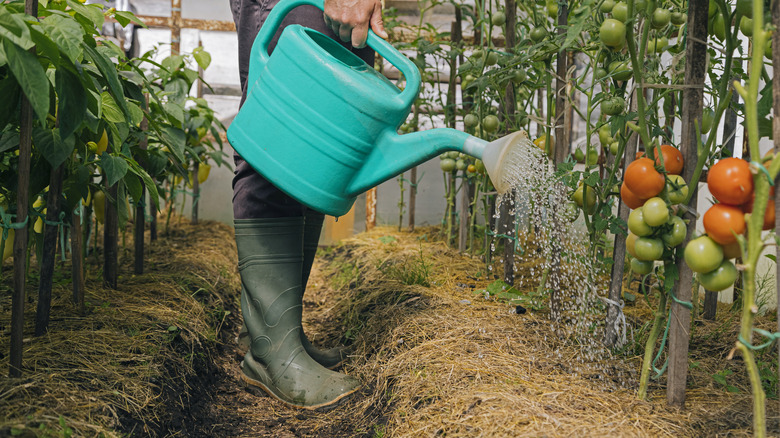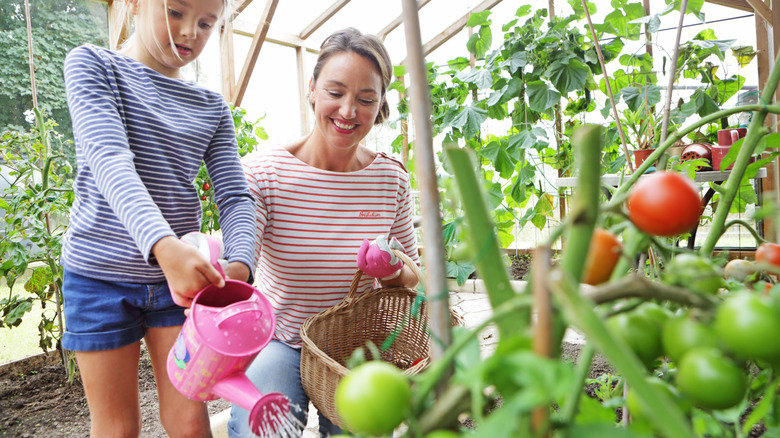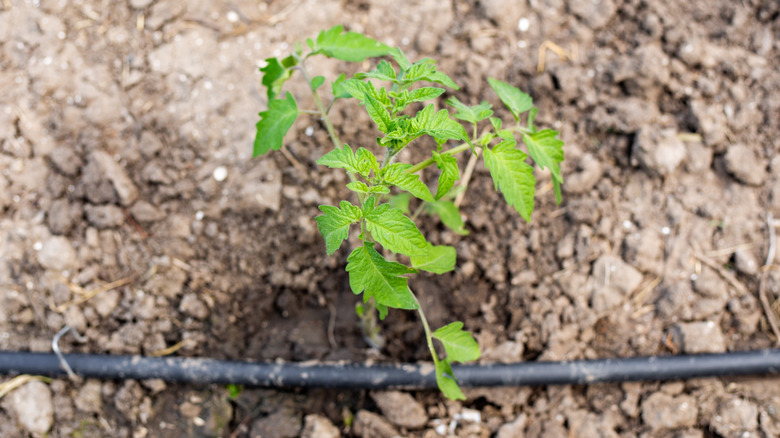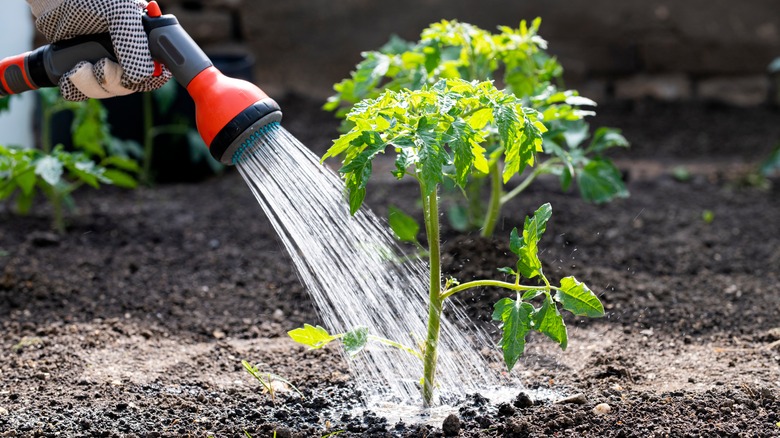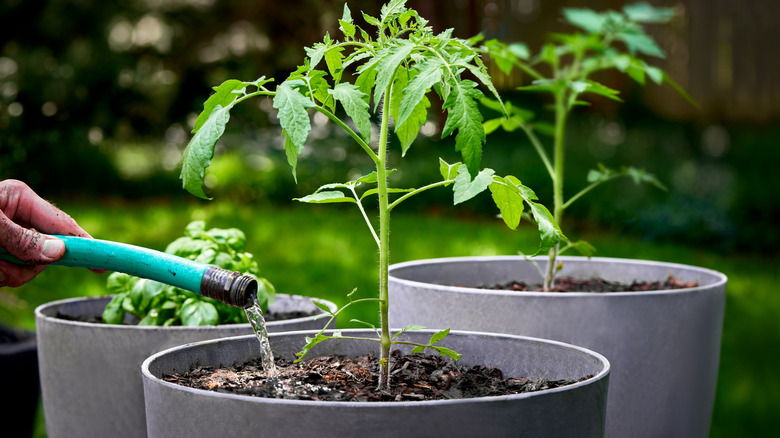Key Watering Tips You're Missing For Bigger, Healthier Tomatoes
We may receive a commission on purchases made from links.
There's a reason so many gardeners love growing tomatoes in their garden. Not only are they tasty, but one plant's crop yield can be nearly overwhelming if you're not prepared. However, there's also the flipside when you're left wondering why your tomato plant's fruits are sad-looking, bland, or even non-existent. In times like these, we'll often look to the soil for the culprit, thinking that maybe the nutrients are lacking or you just got a bad plant this year. But what if the problem was simpler than that — what if it's your water routine?
It seems almost insulting to think it could be your watering, but getting it right is often trickier than it appears, especially if this is your first year growing tomatoes. After all, watering isn't just about keeping your plant alive; it's a complex, strategic practice that affects your plant's health and its fruit's size and flavor. So, let's break down the key parts of a water routine and explain why it affects your tomatoes, as well as how to get things back on track. The good news is, it's probably easier than you think, so grab your watering can and let's get to it.
First, test your water
If you're watering with a hose linked to your tap, it could be the salt content, known as "salinity," of your water is too high for your tomato plants to handle. Low levels of sodium naturally occur in our water, and some studies have shown that salinity in irrigation can improve a tomato's quality, making it denser, more acidic, and rich in vitamin C. But there's a trade-off here: You'll get better fruits, but lower yields, which may give you a hint at what the problem is. When the salinity gets too high, it stresses the plant by inhibiting its nutrient uptake, stunting its growth, and attracting pests like the aptly-named tomato leafminer (Tuta absoluta). So, if you're trying to grow a lot of tomatoes, high salinity is going to hurt your plans.
So, what's to be done? First, get your water tested. You can get a meter yourself, like this YINMIK pH Salt Meter 5 in 1 pH TDS EC Salinity Tester, or have it sent to the lab for a more thorough analysis. If it comes back that your water has high levels of salt, you'll need to find a new water source for your garden's irrigation. Luckily, it's easy to DIY your own rainwater barrel, especially if you're able to connect it to a downspout and catch all of that water run-off from your roof. There are also water filters that attach to hoses, like this H&G Lifestyles Garden Hose Water Filter, but it's unclear how well they work at reducing salinity. Scientists are working on developing more salt-tolerant varieties of tomato plants, but chances are they'll be available for commercial farming long before we can get our hands on them, so for now you'll need to treat the problem at the source.
Create a water routine based on your soil type
Obvious statement of the century incoming: Every garden is unique based on several variables. While that's probably not a surprise to you, we've noticed that some gardeners don't take that into account when creating their watering routine, which is a shame because your soil type is just as important as any other garden tool. Going in with a one-size-fits-all method can easily lead to over- or under-watering, both of which can hinder a tomato plant's fruit production. So you need to adjust your watering routine based on the soil type to ensure your tomato plants get the consistent moisture they need to thrive.
You see, your soil type should impact your watering routine, because it creates the literal foundation for how much water your plant can access. Clay-heavy soils tend to hold onto moisture longer than sandy types, so a weekly dousing of water could mean different things in different gardens. But how do you know what type of soil you have? You can send soil samples to your local university extension to get it tested for the most accuracy or, for a quick and dirty option, simply stick your finger in the soil before watering. If the soil feels dry around 1 to 2 inches down, it's not holding moisture, so can take in a good watering. However, if you pull your finger up and it feels moist or there's loose soil clinging to your finger, there's still water being retained and it's not time to water your plants yet.
Water early in the day
You may be more of a night owl than an early bird, but getting up earlier to water your garden can pay off dividends. You've probably noticed that tomatoes are high in water, and that's because the plant prioritizes water delivery to its fruits through a vascular system called the xylem. The earlier plants have access to water in the day, the more of a chance they have to soak it up before evaporation begins, and the more moisture they have, the more plump, juicy tomatoes they can produce.
The best time to water your plants is early in the morning before the sun gets too high, because it keeps evaporation to a minimum and ensures the water has time to soak into the soil. While watering after work is also an option and certainly better than not watering at all, it's not the best route to go if you can avoid it. You still want some evaporation to occur and that's hard to do when the sun has set. Otherwise moisture will stay on the leaves, inviting pests and diseases that love damp, cool conditions.
Whatever you do, do not skip watering
We get that you might be feeling overwhelmed with all of this structure, but if we can teach you one thing, it's this: Whatever you do, do not skip watering your tomatoes. Watering your tomatoes isn't just a suggestion, it's a non-negotiable part of growing tomatoes. No matter the stage of life your plant's in, drought stress, even for a short time, can have a significant impact on fruit production. Your plant doesn't know that you're just not feeling it today and will take it as a worst-case scenario that water isn't coming any time soon, so will begin to prioritize its survival over growing fruits. You'll notice signs of drought stress when its growth slows, its leaves change color, or it begins to prematurely drop flowers and fruits. Plus, if you decide to overcompensate and get into a routine of drought followed by over-saturation, that can lead to other issues, like blossom-end rot, which makes the bottoms of tomatoes turn brown as they rot from the inside out.
But you can't dictate your life based on your tomato plants, so what can you do? If you're someone who likes to travel or live somewhere that issues water restrictions, you're going to need to plan ahead. Consider an automated irrigation system, like a drip irrigation setup with a solar pump that's attached to a water barrel, like this Breeze Touch 50FT Automatic Solar Drip Irrigation System. You can also mulch around the base of the plant to help reduce evaporation and the chance of drought stress, but you're still going to need to keep a consistent watering schedule. If you live somewhere with water restrictions, you may be able to get away with a reduced water schedule, but need to tweak your nutrient levels, which may be difficult. A 2024 study in Scientific Reports found that tomato plants could carry on with reduced irrigation, but only if nitrogen levels were also reduced. That might be hard, as most fertilizers have nitrogen as a primary ingredient, so it's probably easier to just try and save water in a rain barrel and hook an automated irrigation system to it.
Water new transplants daily during the first week
To give your tomato plants the best possible start, try watering them every day during their first week in your garden. This stage is when your new baby tomato plants are setting down roots, literally, so they need a consistent supply of moisture. Otherwise, the roots won't develop and weak roots mean more nutrient and water delivery, resulting in sad crop yields or none at all. Remember to keep your soil type in mind, though, and watch out for overwatering, especially if you've got clay-heavy soil.
However, you can back off the daily water routine after the first week and slowly wean your plants down to a more normal watering schedule. Ideally, you should shoot for giving your growing plant around 1 to 1 1/2 inches of water per week to encourage strong, deep root growth. Figuring out 1 inch of water might be harder than it sounds, but its one of the essential measurements for watering deeply to ensure success, so here's a quick way to figure it out: 1 inch of water equals 0.62 gallons per square foot of garden, so if you've got 100 square feet of tomato crops you need to water, you'll need 62 gallons a week. Get a hose meter, like this RESTMO Water Flow Meter, or use a watering can with marked levels to help measure it out.
Water every three to five days during growing season
Once your tomato plants are past their baby stage, switch to a schedule of every three to five days. During the growing season, a consistent level of soil moisture is critical for ensuring your plants have a steady supply of water. Low soil moisture can create a domino effect, as your plant goes into survival mode, resulting in smaller fruit, fewer flowers, and a higher chance for blossom end-rot. It can also restrict leaf growth, and the fewer leaves it has, the more chance your fruits have to get sunburnt.
To nail your watering schedule down just right, you'll need to pay attention to the environmental conditions your garden gets, like sunlight, temperature, wind levels, etc. During hot, sunny, or windy periods, your plants will probably need you to come down and water them every three days to make up for what's evaporated, while cooler temperatures and cloudy days let you stretch your watering out a little more. The better you get at paying attention to moisture levels and environmental factors, the more consistently moist your soil will stay, making your tomato plants healthy and strong enough to produce some seriously amazing fruits.
Increase your watering once you start to see fruits
As we've mentioned, tomatoes need a consistent supply of water to produce big, beefy fruits. But it's when you see those fruits that you'll need to step up your water routine even further, because the plant's water requirements have officially gone through the roof. Before it was just growing and doing its thing, and now it now needs to push more water into fruit production, in addition to having enough to simply stay alive. During the flowering and fruit formation stages, water deficiency can have serious consequences. You may notice fewer flowers — which are where the fruits grow — smaller tomatoes, and lower yields; all of which are signs telling you to up its watering ASAP.
During the growth phase, every three to five days is good, but the fruiting stage is when you should pay more attention to the soil's moisture level instead of a calendar. You can use a moisture meter if you want, or try the kitchen utensil hack that prevents overwatering. Insert a wooden chopstick near the base of the plant and give it a little twist, then pull it out. If there's soil on the stick, there's still moisture in the soil, so your plant should be okay or just needs a little sip of water. If the chopstick comes back dry, get the watering can out, because the soil is so dry even a porous material like wood couldn't get your dry dirt to cling to it.
Utilize drip irrigation instead of your hose
Whew, it's a lot to keep in your head, huh? Why not save yourself a lot of mental load and instead use the watering technique that saves money and water: drip irrigation. Drip irrigation is one of the best ways to ensure your tomatoes get the water they need regularly, resulting in both bigger tomato fruits and less water usage . A 2023 study in Environmental Processes noted that drip irrigation increased yields on tomato plants by 28%, all while using less water than you would with a hose or watering can.
Drip irrigation works by using thin tubing that lies on the ground to deliver moisture directly to the plant's roots, saving water that would've otherwise evaporated on the leaves and stems. There are two versions of drip irrigation, and which one you use depends on how many plants you have. If you're growing rows of tomatoes, go with a soaker hose setup, like this AIODE 50 ft Soaker Hose. Soaker hoses can be hooked up to a tap or automated via solar pump and a water source. They have little holes throughout the tube and use water pressure to push water down the length while it slowly drips water out, essentially like an intentionally leaky hose. The other option is to use solid irrigation tubes that have a plastic irrigation stake, like this JYIANG Solar Automatic Drip Irrigation Kit System. These systems are better for raised bed gardens or container plants, as the tubes can be cut to any length and only deliver water through the stake, so you don't need to worry about water leaking out on its way to your tomato plant.
Water the soil, not the leaves
If you want to stick with the manual method, make sure you're aiming your hose or watering can at the soil, instead of over the tomato plant. By hitting the soil instead of the leaves, you get the water right where it needs to go so that the roots can deliver it up to the fruits, plumping them out. Plus, it prevents water from staying on the leaves, which is an invitation for foliar disease and pests, in addition to just wasting it, thanks to evaporation.
When you water at the base of the plant, make sure to give it a concentrated stream of water so that it gets a good, deep drink and not a quick once-over misting. It's like the difference between an industrial fan and an oscillating one, where you get a direct blast of air versus the occasional back and forth wisp. Remember, you're aiming for around an inch of water per plant, per week, so take a few minutes to soak the soil deeply.
Back off watering when you have heavy rainfall
Backing off your watering after a good summer rainstorm is crucial for preventing a host of problems that can ruin tomato fruit production. It's just too much of a good thing; while tomato plants need consistent moisture, too much can end up being just as harmful as too little. It creates an environment that not only encourages fungi and pests, but can lead to root rot, which turns strong roots into mush. Without the strong roots, there's nothing to deliver water to the plant, so it backs off growing fruits and slowly dehydrates until it dies.
So, if you have a heavy rainfall, check the soil's moisture before breaking out the garden hose and don't water if it's already moist. Also, heavy rains sometimes wash away essential nutrients your plant needs for growing tomatoes, so you may need to give it a hit of fertilizer, depending on how long it's been and your plant's growth stage. But, like too much water, too much fertilizer can be detrimental to fruit production as well, so don't go crazy.
Give container-grown tomato plants even more water
Container-grown tomato plants need even more water than in-ground plants, so you likely need to water them even more frequently. It's due to their roots; in-ground tomato plants can spread their roots far and wide to search for water, while potted tomato plants get to go as far as the pot's wall. Since there's a limited amount of soil, the plant has less to draw from and so it will dry its soil out faster, leaving it susceptible to water stress. The more water stress the plant deals with, the more it goes into survival mode and will conserve water instead of pushing it to the tomatoes, resulting in smaller fruits or fewer crop yields.
You may need to water container tomato plants daily during the summer, but keep an eye on the soil's moisture level and only water when the first inch or so feels dry. However, and this is where it gets tricky, don't give it so much water that you see it coming out of the drainage holes. This means the soil is officially at moisture capacity and all that's happening is nutrients are being pushed out and water is being wasted. Remember the goal is consistent moisture and not over-saturation.
